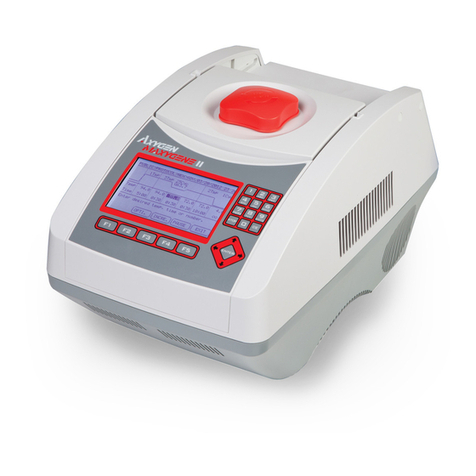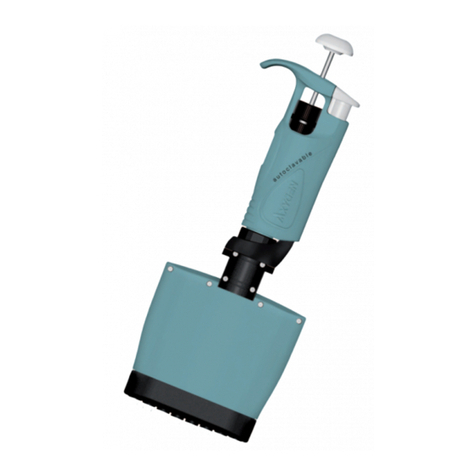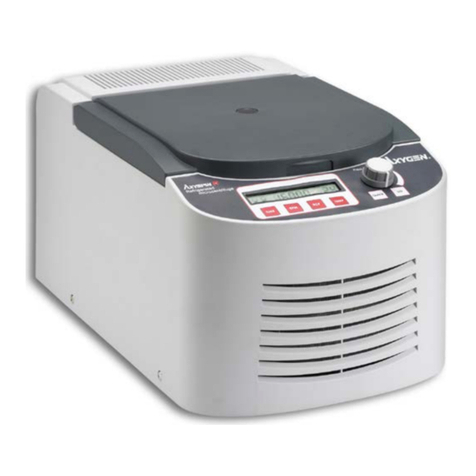ENGLISH
ejector by turning the screwdriver
counter-clockwise.
Possible problem Damage to the piston or seal due to
prolonged use with the aggressive
liquids.
Action Disassemble the pipette as described
above. Replace the piston, seal and
O-ring (see Section 12). Rinse the
inside of the shaft in distilled water
and dry. Lubricate the seal and O-ring
with the lubricant, that is included
with each pipette. Following piston
replacement, a calibration procedure
is required.
Note: The parts of AP-2 and
AP-10
pipette should be lubricated
evently with a minimum amount of
lubricant.
Possible problem
The pipette is reassemled improperly.
Action Disassemble the pipette and
reassemble it, observing the proper
sequence of steps (Fig. 3).
Possible problem No lubricant on the sealing elements.
Action Remove the tip ejector. Unscrew the
shaft nut, remove the shaft, piston
assembly, seal and O-ring. Rinse the
removed parts in distilled water and
dry thoroughly. Lightly lubricate the
inside surfaces of the seal and the
O-ring with the included lubricant.
Reassemble the pipette in the reverse
order.
Possible problem Contamination of the inside of the
pipette caused by extensive aspiration
of chemically aggressive liquids or
because liquid got inside the pipette.
Action Remove the tip ejector. Unscrew the
nut, remove the shaft, piston assembly
,
seal and O-ring. Rinse the removed
parts with distilled water and dry
thoroughly. Lightly lubricate the
inside surfaces of the seal and the
O-ring with the lubricant. Reassemble
the pipette in the reverse order.
If you find an increase in the pipetting force, which
could happen after repetitive autoclaving of the pipette:
Action Remove the tip ejector. Unscrew the
shaft nut, and then remove the shaft,
piston assembly, seal and O-ring.
Rinse the removed parts in distilled
water and dry. Lubricate the internal
surfaces of the seal and O-ring with
lubricant that has been included with
each pipette. Reassemble the pipette
in opposite order.
Note: All parts of the pipette can
be autoclaved (see Section 10).
The shaft of the AP-5000 and
AP-10ML models should be auto-
claved without the filter.
If the problem continues after carrying out the above
steps, contact your AXYPET representative.
Before returning the pipette, please ensure that the
pipette is completely free of any chemical, radioactive or
microbiological contamination which could pose a threat
during transport and repair. As far as it is possible, clean
the pipette.
10 - CLEANING AND STERILISATION
Cleaning
External surfaces of the pipetting pushbutton, the ejector
pushbutton, the handgrip, the shaft nut and the adjustment
knob may be cleaned using a cloth dampened in
isopropyl alcohol. The remaining parts removed from the
pipette during pipette disassembly may be washed with
distilled water or isopropyl alcohol.
Sterilisation:
The pipette can be sterilised in an autoclave at 121°C for
20 minutes. After sterilisation, the pipette should be dried
and cooled to room temperature
It is recommended:
- to sterilise the pipettes in autoclave with an initial vacuum
and drying cycle,
- prior to sterilisation unscrew the shaft nut slightly in the
AP-2 to AP-1000 pipettes, and unscrew the shaft slightly
in the AP-5000 and AP-10ML. After autoclaving these
parts should be screwed tight again.
13 14































